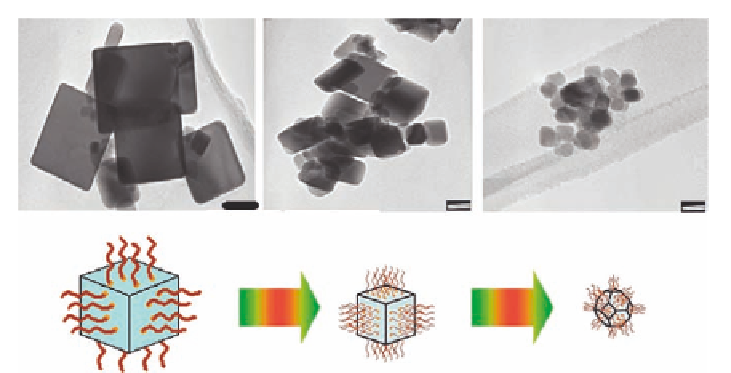Geoscience Reference
In-Depth Information
MR = 6:1
50
nm
MR = 24:1
20
nm
MR = 40:1
20
nm
Figure 10.31 Mechanism for size control in Co
3
O
4
nanoparticle fabrication under SCF
conditions (T
5
300
C, P
5
20 MPa, surfactant is hexaldehyde) with molar ratio (MR) of
starting material to the modifier.
Source: Courtesy of T. Adschiri, Tohoku University, Japan.
through the conversion of diaspore to corundum under hydrothermal conditions.
This nanosized alumina has great application potential. The authors were able to
develop a new transitional alumina reaction sequence that gave rise to an alpha
intermediate structure,
α
0
-Al
2
O
3
with a very high surface area. Also they have
investigated the thermodynamic basis and equilibrium relationships for the nano-
crystalline phases.
Wang et al.
[139]
have reported the synthesis of Dy
2
O
3
nanorods under hydro-
thermal conditions at 180
C in about 24 h. Dy
2
O
3
was dissolved in concentrated
HNO
3
, and the pH was adjusted to 7
8 using 10% KOH solution. Then the precip-
itate was transferred to an autoclave for hydrothermal
treatment. The thermal
decomposition of Dy(OH)
3
gave rise to Dy
2
O
3
nanorods.
Sorescu et al. [137a] have synthesized nanocrystalline rhombohedral In
2
O
3
under hydrothermal conditions at about 200
C in 4 h [140]. This In
2
O
3
has a corun-
dum structure and is a high-pressure phase crystallizing with a rhombohedral
structure. The hydrothermally treated product was postannealed at 500
C.
Several workers have prepared the
-Fe
2
O
3
(hematite) phase as nanoparticles
under hydrothermal conditions (using both aqueous and nonaqueous solvents) with
or without surfactants
[133
α
137, 141]
. These hematite particles find extensive
applications such as catalysts, pigments, recording medium, and sensors.
Hydrothermal method shows advantages over conventional methods like sol
gel
and hydrolysis of iron salts. Surfactants like sodium dodecylsulfonate, SDBS, cetyl-
trimethyl ammonium bromide (CTAB), and hexadecylpyridinium chloride have
been used. Fe(NO
3
)
3
9H
2
O or FeC
2
O
4
was used as the source of iron. NaOH or N,
N-dimethylformamide was used as a solvent. The experimental temperature ranges

